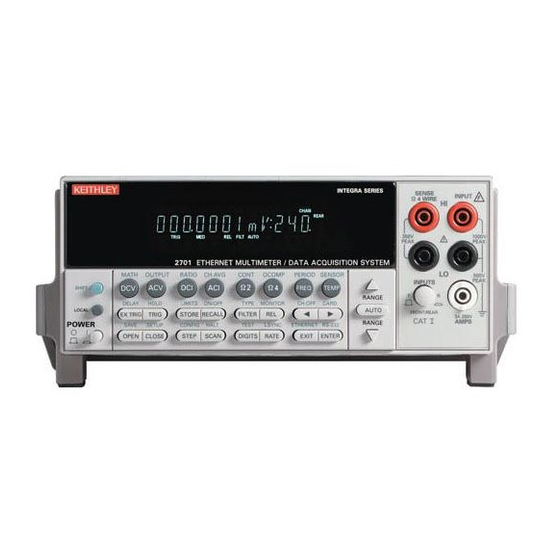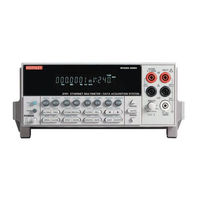
Keithley 2701 Manuals
Manuals and User Guides for Keithley 2701. We have 5 Keithley 2701 manuals available for free PDF download: User Manual, Service Manual, Instruction Manual, Quick Start Manual
Keithley 2701 User Manual (506 pages)
Ethernet-Based DMM/Data Acquisition System
Brand: Keithley
|
Category: Measuring Instruments
|
Size: 5 MB
Table of Contents
-
-
-
-
Connections71
-
Pseudocards72
-
-
-
-
-
Connections112
-
-
Connections124
-
-
-
Thermocouples137
-
Thermistors140
-
4-Wire Rtds141
-
Connections142
-
-
-
Trigger Level150
-
Gate Time150
-
Connections151
-
-
-
-
Range
168-
Manual Ranging169
-
Auto Ranging169
-
Scanning169
-
-
-
-
Basic Operation190
-
Relative
190
-
-
-
Math195
-
MX+B196
-
Percent197
-
Reciprocal (1/X)198
-
Basic Operation199
-
-
Buffer
211-
Buffer Overview212
-
-
Auto Clear212
-
Timestamps214
-
Storing Readings215
-
-
-
Buffer Commands218
-
-
-
6 Buffer
219 -
Scanning
227-
-
Scan Reset239
-
Simple Scan239
-
Advanced Scan240
-
Setting Delay244
-
Monitor Channel244
-
Saving Setup247
-
Auto Scan247
-
-
Scan Operation247
-
-
Trigger Model252
-
Channel Setup253
-
Buffer253
-
-
7 Scanning
254 -
Triggering
265-
Trigger Model266
-
Idle266
-
Device Action269
-
Output Trigger269
-
-
-
8 Triggering
268 -
8 Triggering
271 -
-
Limits284
-
Scanning286
-
Digital I/O287
-
-
-
-
-
Pseudocards302
-
Autozero302
-
Db Calculation302
-
-
System Commands303
-
-
-
Ethernet Setup307
-
-
-
-
LOCAL Key320
-
-
Command Words321
-
Query Commands323
-
Case Sensitivity323
-
Short-Form Rules324
-
Program Messages324
-
-
-
Baud Rate328
-
Terminator330
-
Error Messages333
-
Status Structure
335 -
-
Queues356
-
Output Queue356
-
Error Queue356
-
-
Common Commands
359 -
-
Reference Tables384
-
-
-
Specifications
411
-
-
-
Screw Terminals424
-
Wiring Procedure426
-
Connection Log430
-
Advertisement
Keithley 2701 Service Manual (168 pages)
Ethernet-Based DMM / Data Acquisition System
Brand: Keithley
|
Category: Multimeter
|
Size: 3 MB
Table of Contents
-
-
Introduction16
-
-
-
-
-
Introduction48
-
-
Line Power48
-
-
-
-
-
Introduction71
-
-
-
Introduction79
-
-
Power Supply82
-
-
-
-
-
Introduction98
-
-
-
Introduction112
-
Parts Lists112
-
Factory Service112
-
Specifications
131-
DC Volts133
-
DC Current133
-
Ac Current134
-
-
Keithley 2701 Service Manual (135 pages)
Ethernet-Based DMM / Data Acquisition System
Brand: Keithley
|
Category: Multimeter
|
Size: 12 MB
Table of Contents
-
-
Calibration
37-
Introduction37
-
-
Line Power38
-
-
-
Introduction60
-
-
-
-
Power Supply73
-
-
Disassembly
87-
Introduction87
-
-
-
Introduction101
-
Factory Service101
-
-
-
Introduction109
-
-
Temperature113
-
-
Advertisement
Keithley 2701 Instruction Manual (61 pages)
Ethernet-Based DMM / Data Acquisition System Instrument Networking
Brand: Keithley
|
Category: Measuring Instruments
|
Size: 1 MB
Table of Contents
-
Introduction
11 -
-
Keithley 2701 Quick Start Manual (52 pages)
Brand: Keithley
|
Category: Data Loggers
|
Size: 1 MB
Table of Contents
-
Buffer
38




